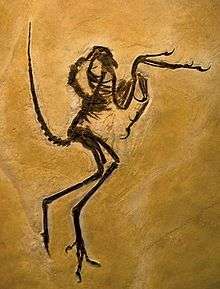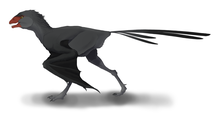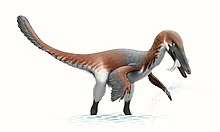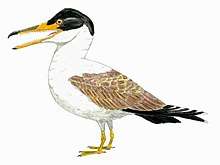Archaeopterygidae
Archaeopterygidae is a group of maniraptoran dinosaurs that lived during the late Jurassic period. In most current classifications, it contains only the genera Archaeopteryx and Wellnhoferia. As its name suggests, Protarchaeopteryx was also once referred to this group, but most paleontologists now consider it an oviraptorosaur. Other referred genera, like Jurapteryx, Wellnhoferia, and "Proornis", are probably synonymous with Archaeopteryx (the former two) or do not belong into this group (the last). Jinfengopteryx was originally described as an archaeopterygid, though it was later shown to be a troodontid.[2][3][4] A few studies have recovered Anchiornis and Xiaotingia (usually considered more primitive members of the related group Deinonychosauria) to also be members of the Archaeopterygidae,[5] though most subsequent analyses have failed to arrive at the same result. Uncertainties still exist, however, and it may not be possible to confidently state whether archaeopterygids are more closely related to modern birds or to deinonychosaurs barring new and better specimens of relevant species.[6]
| Archaeopterygids | |
|---|---|
 | |
| Berlin specimen of Archaeopteryx lithographica | |
| Scientific classification | |
| Kingdom: | Animalia |
| Phylum: | Chordata |
| Clade: | Dinosauria |
| Clade: | Saurischia |
| Clade: | Theropoda |
| Clade: | Avialae |
| Family: | †Archaeopterygidae Huxley, 1871 (conserved name) |
| Type species | |
| †Archaeopteryx lithographica von Meyer, 1861 (conserved name) | |
| Genera | |
| Synonyms | |
| |
Classification

The family Archaeopterygidae is the only family in the order Archaeopterygiformes, which was coined by Max Fürbringer in 1888 to contain Archaeopterygidae and genus Archaeopteryx.[7] A formal phylogenetic definition for Archaeopterygidae was given by Xu and colleagues in 2011: the clade comprising all animals closer to Archaeopteryx than to the house sparrow or Dromaeosaurus.[5]
The family Dromaeosauridae, traditionally considered to be non-avian dinosaurs, have been included in this group by at least one author.[8] Discoveries of a number of primitive forms have muddied the relationships of early birds, making it possible that Velociraptor and similar dinosaurs could be considered birds. Palaeoartist Gregory S. Paul placed dromaeosaurids in Archaeopterygiformes for these reasons, though the eventual cladistic definition of Archaeopterygidae explicitly excluded them.[8]
References
- Brodkob, Pierce (1963). "Catalogue of fossil birds 1- Archaeopterygiformes through Ardeiformes". Biological sciences, Bulletin of the Florida State Museum. 7 (4): 180–293. Retrieved 30 December 2015.
- Ji, Q.; Ji, S.; Lu, J.; You, H.; Chen, W.; Liu, Y. & Liu, Y. (2005). "First avialan bird from China (Jinfengopteryx elegans gen. et sp. nov.)". Geological Bulletin of China. 24 (3): 197–205.
- Chiappe, L.M. (2007) Glorified Dinosaurs: The Origin and Early Evolution of Birds. Sydney: UNSW Press. ISBN 0471247235.
- Turner, Alan H.; Pol, Diego; Clarke, Julia A.; Erickson, Gregory M.; Norell, Mark (2007). "A basal dromaeosaurid and size evolution preceding avian flight". Science. 317 (5843): 1378–1381. Bibcode:2007Sci...317.1378T. doi:10.1126/science.1144066. PMID 17823350.
- Xing Xu; Hailu You; Kai Du & Fenglu Han (28 July 2011). "An Archaeopteryx-like theropod from China and the origin of Avialae" (PDF). Nature. 475 (7357): 465–470. doi:10.1038/nature10288. PMID 21796204. Archived from the original (PDF) on 20 December 2016. Retrieved 5 November 2016.
- Lee, M. S. Y. & Worthy, T. H. (2011). "Likelihood reinstates Archaeopteryx as a primitive bird". Biology Letters. 8 (2): 299–303. doi:10.1098/rsbl.2011.0884. PMC 3297401. PMID 22031726.
- Fürbringer, M. (1888) Untersuchungen zur Morphologie und Systematik der Voegel, Amsterdam, van Halkema, p. 1751
- Paul, G.S. (1988). Predatory Dinosaurs of the World. New York: Simon and Schuster.
Catalogue of fossil birds



.png)





.png)


